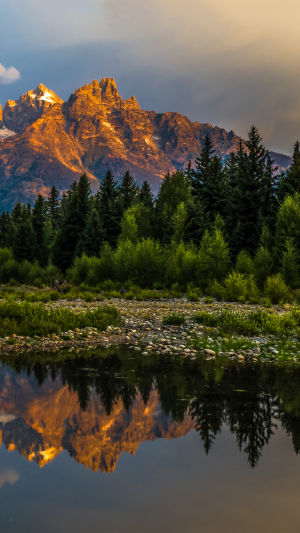If you haven't heard of Grand Teton National Park, then you have seen the Paramount movie with the snow-capped mountain tops surrounded by a circle of five-pointed stars.
It is the Grand Teton, National Park.
Grand Teton National Park, located in the spectacular glacial mountains of northwestern Wyoming, south of Yellowstone National Park, in alpine terrain, was established in 1929 and encompasses 1,256 square kilometers.
Famous for its rolling snow-capped peaks, the park stretches for more than 200 miles along the Grand Tetons, accompanied by the Snake River, which flows through the national park.
The park's majestic snow-capped mountains, vast grasslands, pristine lakes, and abundant wildlife make it a beautiful picture.
The most famous of the glacial lakes in the area is Jenny Lake.
Jenny Lake is the largest water body in the area.
The tops of the towering mountains are covered with glaciers that have been there for a thousand years.
The park is home to herds of American bison, elk, and antelope, as well as many other species of mammals.
Jenny Lake is the second largest lake in the Grand Tetons, and one of the more important attractions on the western route.
Jenny Lake is also the first famous attraction after entering Grand Teton National Park.
On a clear day, you can see the beautiful reflection of the Tetons on the lake while enjoying the clean snow-capped lakes.
Jenny Lake is best known for two ways to enjoy the lake, one is to hike around the lake on Jenny Lake, which is about 10 kilometers long, and goes into the mountains to explore the area.
The other is to take a boat trip to the other side of the lake. But you need to book the boat ticket in advance during the high season.
The Grand Tetons has a small mountain range about 60 kilometers long and 20 kilometers wide, and there are only eight peaks in this small range that exceed 3,658 meters above sea level.
The highest of these peaks is only 4,198 meters above sea level.
After the uplift of the Grand Tetons, millions of years of erosion washed away the relatively soft layers of sedimentary rock that were originally the outer layer of the mountain range, exposing the hard granite and gneiss that made up the deeper layers of the earth.
After the Ice Age, about 150,000 years ago, the climate gradually became colder.
The snow accumulated year after year in the mountain depressions or at the headwaters of streams, and the depressions or water sources were subjected to snow avalanches from the nearby mountains, causing the deep snow to accumulate into ice.
So many beautiful sceneries that you have not come to see?
You will enter Grand Teton National Park through the North Gate.
After the tour, you can exit Grand Teton National Park through the south gate.
If you choose to visit Grand Teton National Park between June and September, it is recommended that you wear long sleeves and long pants even in the summer months of July and August due to the large temperature difference between morning and evening.





